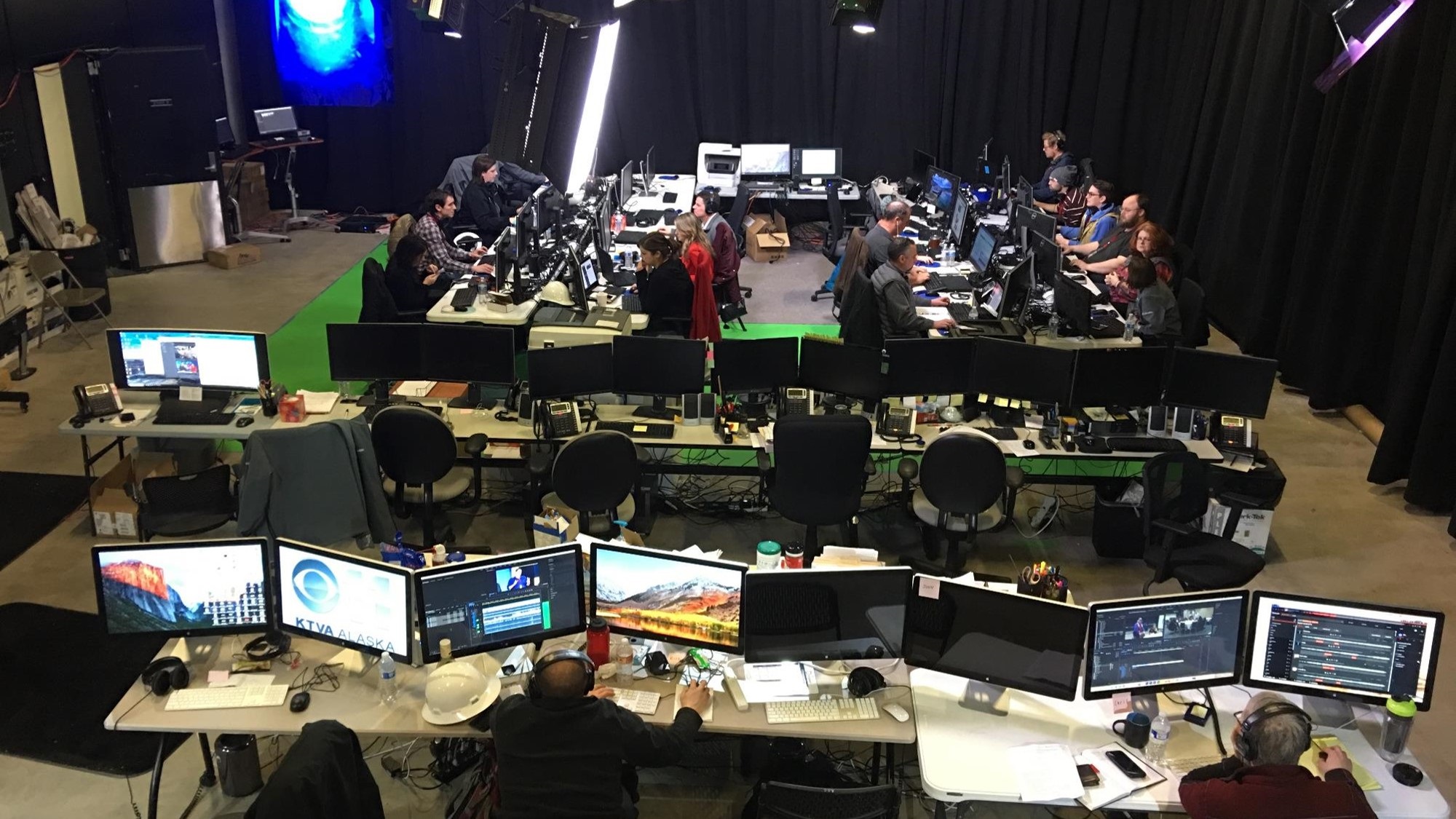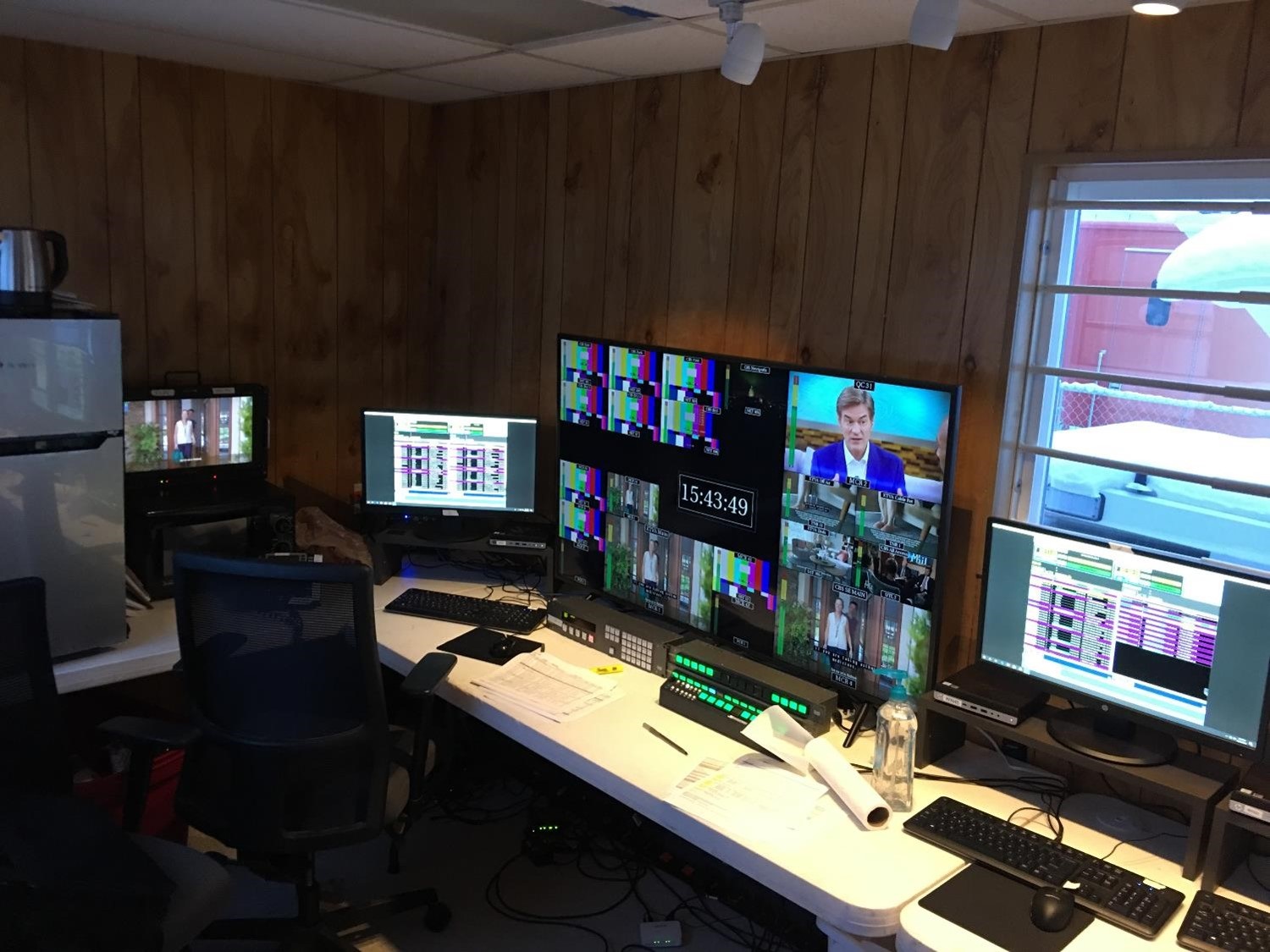ANCHORAGE, Alaska—It’s been a little more than a year since a 7.1 magnitude earthquake struck Anchorage, but Erik Kuhlmann, director of engineering and operations at Denali Media/KTVA, remembers the temblor like it was yesterday.
“The first 10 seconds, it was just a normal earthquake,” recalls Kuhlmann, who was seated at his desk at 8:29 a.m. on Nov. 30 when the quake struck. “Then it became violent. I knew we were in trouble.”
Jumping to his feet, Kuhlmann bound over his desk and headed to the shop door as he dodged about 15 iMacs that moments before were sitting securely on a shelf but had become airborne in the shaking. “I had stored a ladder behind the door, and it fell down, blocking the door. So it became very difficult to get out,” he says.
Eventually, Kuhlmann freed the blocked door and ran to the newsroom to help anyone who might have been injured and to evacuate people from the building. As luck would have it, the newsroom was empty because of the hour and the fact that the morning show was over. The few people in the production control room were able to exit the building with Kuhlmann.
According to the U.S. Geological Service, the Nov. 30, 2018, quake was centered north of Anchorage near Joint Base Elmendorf-Richardson, occurring in the Alaska-Aleutian subduction zone. Unlike 1964 Anchorage and 2002 Denali earthquakes, this one was deep, rupturing the earth about 30 miles below the surface where the Pacific Plate is forcing itself under the North American Plate.
KTVA, the CBS affiliate serving Anchorage, Sitka, Juneau and Ketchikan as well as a number of cable systems throughout the region, just happened to be located in a part of Anchorage that took severe damage. But despite the quake’s severity no one was injured at the station.
“We got everybody outside, and we waited for somebody to do something or give an all clear,” says Kuhlmann, “but I knew that was not going to come. And we still had a TV station to run.”
The professional video industry's #1 source for news, trends and product and tech information. Sign up below.
THE DAMAGE
At the time of the earthquake, KTVA shared a 1980s era building in the northeast part of Anchorage with several other businesses, including its parent company GCI. While there were few station personnel in the building when the quake struck, some 20 to 30 people—mostly employees of other tenants—made their way outside, says Kuhlmann.
Once it was clear no one was hurt, Kuhlmann re-entered the building. First up was restoring power. The quake had tripped the main breaker, and resetting it was quick work.
Dealing with the water from the sprinkler heads that broke proved to be a bigger challenge, however. “Sprinkler heads were broken all over the place, and it took between four and five hours to get them shut off. So, in that period of time there was a lot of flooding,” says Kuhlmann.
The newsroom, common hallways and other areas were drenched as water flowed down from overhead. Fortunately for KTVA, most of its operations were located on the second story of the building, so water didn’t accumulate and began to find its way down to the first floor, preventing an even bigger disaster.
Fallen ceiling tiles were everywhere. In the production control room, the entire ceiling—tiles, supporting grid work and track lights—landed on top of countertops, the production switcher and other equipment. In the newsroom, the tiles lay scattered atop broken glass strewn about from shattered edit bay doors and walls. Soon, the constant soaking from the broken sprinkler heads began to disintegrate the tiles. Newsroom set pieces and supportive facades also gave way and dangled from the ceiling.
The quake also toppled two robotic cameras in KTVA’s second floor studio and damaged a teleprompter screen. “That’s heartbreaking to see such expensive equipment just thrown on the floor,” says Kuhlmann. Regardless of the dents and dings to other cameras and equipment, the station’s technology largely survived and “operated just fine,” he says.
Most of the damage to equipment was confined to computer and TV monitors mounted to the walls and thrown off. “As good as drywall anchors are, they don’t survive earthquakes, and all of those screens came down,” says Kuhlmann. In all, the station replaced about 30 monitors.
Despite the overall devastation, there were a few bright spots. The building’s natural gas hookup remained intact, was inspected and determined to be safe, enabling the building to be heated. “It was wintertime and cold outside. We needed the heat,” says Kuhlmann.
The station’s machine room was largely unaffected with the exception of holes punched in the walls by the ceiling-mounted HVAC system as it swayed back and forth during the quake. “Outside of that, everything is seismically braced in that room on an elevated floor, and it rode it out just fine,” he says. Fire protection in the room was on a dry system, so it did not suffer any flooding.
The station’s large studio on the first floor of the building appeared to be intact. Ditto for KTVA’s microwave link to its transmitter site 7 miles away in the middle of Anchorage. So, the station’s transmitter remained whole. However, as time passed, pixelization and tiling began to show up in the station’s video, so Kuhlmann and his crew switched over to KATV’s backup dark fiber STL.
FIRST RESPONSE
Despite the quake and the damage, KTVA remained on the air uninterrupted. “The most important thing—outside of our own safety—was to get the news to the public,” says Kuhlmann. “Our community in Anchorage was really cut off and isolated with the roads and the bridges being closed down and a lot of areas without power. So it was important that we get the news out.”
However, maintaining its on-air presence was a major effort on the part of Kuhlmann and the KTVA staff.

“We worked all day cleaning up the facility,” says Kuhlman, “just working area by area, depending upon the critical nature and use of the space.”
With power restored, the next priority was to re-enter the building with people to operate master control to make sure the station was still on air and keep it that way, recalls Kuhlmann. The next priority was the newsroom, followed closely by the production control room.
Kuhlmann and others used ropes to secure facades dangling from the newsroom ceiling. “Once we were able to do that, we were able to get some newsroom people in there and start shooting,” he says.
The station began its wall-to-wall coverage of the quake. News staff initially began shooting with their iPhones, putting that video on air. Then the staff began to shoot and stream live and raw footage directly to air from their Dejero IP newsgathering units. Within 30 minutes, the station had an uplink to CBS Los Angeles, and within a couple of hours it had put its helicopter in the air to report on the damage to Anchorage’s highways, he says.
The goal was to return “some semblance of normalcy” to the newsroom, says Kuhlmann. Another critical task was clearing a path through the debris to get people safely into the production control room to begin operating again.
But as the day wore on a new problem surfaced. “The first thing we noticed after the dust started to settle, so to speak, was that it didn’t,” says Kuhlmann. Small particles from the ceiling tiles that fell and the dust and dirt that accumulates in typically inaccessible spaces became airborne. “Everyone was coughing. So we quickly had to get masks for everybody to wear,” he says.
It wasn’t till the next day the reason for the lingering dust became apparent. The station’s main HVAC system that normally circulated and filtered the air was severely damaged and offline.
“There simply wasn’t going to be any airflow for any time in the near future,” says Kuhlmann. With temperatures rising to about 85 degrees for the first few days, there was discussion about breaking out some of the building’s windows to allow fresh air to enter. But eventually, the station settled on bringing in a number of fans to get the air flowing and to help dry out the soaked carpets.
MOVING ON
With such poor air quality in the newsroom, Kuhlmann suggested relocating news to the station’s backup Studio B on the first floor of the building. The studio, a large empty space that was never built out, soon was filled with tables and chairs for the migration. Some lights also were added for a standup position. “That’s where we operated the newsroom for the next few weeks,” he says.
Elsewhere at the station, changes were underway. Studio A, home to the station’s news set, was turned into its main news studio. Offices for sales and administration were cleaned up as best as possible. Those deciding to work from their offices were required to wear hardhats. Many chose to work from home, says Kuhlmann.
Unlike the newsroom, the production control room was on its own, separate HVAC system, so the air quality there remained acceptable, allowing KTVA to forego the complication that would have accompanied its relocation.
As operations slowly returned to normal, the station’s parent company sent in structural engineers to determine whether or not it was safe to continue using the building. Within two weeks, the answer was in: get out.
“At 2 o’clock on Friday [Dec. 14], we were told we had to move out. Our parent company was concerned about apparent liability, and that it would be best to get us out so they could start rebuilding that building,” says Kuhlmann.
Once again, the first priority was master control. To run master control without actually being in master control, KTVA pulled its satellite truck into its parking lot. Engineers dragged fiber optic and network cable from master control across the roof of the building and down to the truck. Five computers were set up in the truck so MC operators could remotely run KTVA and the three other stations that originate there. A phone line was added to maintain communication with other parts of the building, says Kuhlmann.
The newsroom, production control and news studio were moved to a GCI business plaza elsewhere in Anchorage. A wall in one of the rooms was painted green for keying. Remote gear in flyaway cases, ENG lighting and five cameras were moved in. A small Blackmagic Design production switcher was set up and links were established with master control, he says.
Relying on GCI’s dark fiber in Anchorage and Net Insight Nimbra managed media network transport, the station set up multiple paths to feed video back and forth between the sites as well as to extend its network. By Sunday, KTVA’s local newscasts were back on air, says Kuhlmann.
It only took a few days before it became painfully clear how temporary running master control from the satellite truck would be, however. Space was tight, and just using the bathroom required an operator to be escorted by security back into the building. While a portable toilet was brought in to provide relief from that hassle, it offered next to no protection from the Alaskan winter weather, he says.
By the third day of running MC from the vehicle, Kuhlmann decided to order a construction trailer to take its place. “So lifeboat No. 1 was abandoned for lifeboat No. 2,” says Kuhlmann. While the trailer offered adequate heating and more room, it still didn’t have a toilet. It wasn’t till a few weeks later that Kuhlmann could secure “lifeboat No. 3” and relocate across town in a space close to the newly relocated newsroom.

FADE TO BLACK
After evaluating whether it would be best to raze KTVA’s home and start fresh or repair and restore it, GCI chose the latter. “It was deemed that it wasn’t economically feasible to knock it down and start over again,” says Kuhlmann. “The shortest path to restoration was to address those areas that were critical—first and foremost, getting KTVA back in the building and operating—and then focusing on the rest of the building.”
After months of study and restoration, the station returned to the building in May—nearly six months to the day from when the earthquake struck. However, while the station has managed to pick up the pieces, many at KTVA won’t soon forget the stresses of working in television during a natural disaster.

“On a human level, many of the people who work at the station have families,” says Kuhlmann. “Here, you have this horrendous situation that happens to the community at large, and you have this duty that goes above a regular business obligation. You are licensed to serve the public. This is the time when a broadcaster steps up and shows its mettle. But you still have all of these people who have families.”
Some lived near the station and could go home to check in quickly. Others like Kuhlmann lived further away and had to check in by phone when they finally had a moment to themselves. “But it really wears on your mind if you are not home, wondering how bad it is,” he says. “All of those things you feel compelled to investigate, you can’t, because you have to make sure the station is on-air.”
More than a year after the earthquake, many still feel its lingering effects. “Everybody I know, when they hear a low-frequency rumble—maybe it’s just a diesel truck backing up in the street—they stop and make sure it’s not an earthquake,” says Kuhlmann.
KTVA has published a video about the earthquake damage online.
Phil Kurz is a contributing editor to TV Tech. He has written about TV and video technology for more than 30 years and served as editor of three leading industry magazines. He earned a Bachelor of Journalism and a Master’s Degree in Journalism from the University of Missouri-Columbia School of Journalism.

